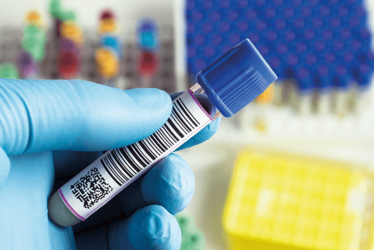What’s on the Box?
Serialization deadlines are nigh, but is the industry ready? We ask six track-and-trace gurus.
The worryingly common misperception that serialization is simply a case of “adding a label to a box” vastly underestimates the complexity of implementation, which includes in-house IT system creation, European/American regulatory data uploading, new packaging requirements, supply chain adaptation, and more.
The deadline set by the FDA for the US is November 26, 2018 (1) – delayed from November 2017 – while the EMA’s EU deadline is February 9, 2019 (2). Given the scale of change required to implement serialization, there’s precious little time for companies to complete the process – even with the US deadline delay. Companies – big and small – may still have queries surrounding the topic, and so to answer those questions and explore the topic in more detail, we’ve gathered a panel of serialization gurus.
The Gurus:

Christoph Krähenbühl is Senior Director at 3C Excellis Europe, and part of the Commercial and Partnership Management team at the European Medicines Verification Organization (EMVO). He was one of the original experts on the European Federation of Pharmaceutical Industries and Associations’ (EFPIA’s) Coding and Serialization team, and has been working on the subject since 2006.

Eric Tjoa is the owner and CEO of Tjoapack. He started the pharmaceutical packaging company in 1989 to improve medication safety in hospitals through coding and serialization. Eric subsequently ventured into a broader range of pharmaceutical packaging services and, ever since, has had the personal goal of helping to contribute to a more efficient and safe pharma supply chain for all.

Frank Binder is the Vice President and Global Head of Supply Chain Management at Santen Pharmaceutical, a drug company specializing in ophthalmology and rheumatology medicines. Frank is in charge of logistics and supply chain projects, and has recently rolled out Santen’s serialization undertaking.

Shabbir Dahod is the CEO of Tracelink, which has developed a track and trace network platform. He began the early part of his career looking at bleeding edge solutions which led to a senior leadership role at Microsoft. Inspired by Sanjay Sarma’s MIT work on RFID and other identification platforms, Shabbir investigated the use of serial numbers to differentiate bottles, leading to his interest in understanding how it could be used to prevent pharma counterfeiting.

Erik Haeffler is the Vice President of Manufacturing Services and the Head of CSR at Recipharm, a contract development and manufacturing organization. He leads Recipahrm’s solids and non-sterile operations in Europe, is responsible for the group’s sustainability work, and is accountable for operations development across the company.

Mark Davison is the founder of consulting firm Bluesphere and the author of the best seller “Pharmaceutical Anti-Counterfeiting: Combating the Real Danger from Fake Drugs”. He is a biochemist by training, and spent his early career at GSK and several biotechs. Mark has spent the last eleven years in supply chain traceability and security.
How have attitudes to serialization changed?
Christoph Krähenbühl: People first started seriously talking about serialization in the pharma industry around 2005, when the focus was very much on stopping fake drugs. A number of technologies were reviewed to help deter counterfeiting, with serialization being just one of the potential solutions raised. Ultimately, I believe that putting a unique serial number on each package and verifying it against a securely kept database is a powerful tool for preventing counterfeits, fraud and theft, but serialization also opens up other opportunities too, in terms of interacting with information and where it flows. In that sense, serialization is not only a tool that offers solutions to a specific problem, but one that also leads to wider opportunities. While the immediate focus needs to understandably rest on achieving compliance with regulatory requirements, visionary companies keep at least one eye on these wider opportunities.
Shabbir Dahod: Initially, there was a lot of resistance to implementation because serialization involves sharing data. But the regulators stressed that the industry needed to do something because counterfeits were damaging everyone, from patients to businesses. The regulators basically indicated that companies needed to work together to come up with an approach that they were satisfied with, which regulators would then evaluate based on how well it protects patients. It’s taken the last 14 years for the industry to find common ground, go to regulators, and say “this is the law we want,” which is why we’re now seeing deadlines in place in the US and the EU. The approach and regulations around serialization will vary between different countries because everyone has to adapt based on the unique dynamics within their own markets.
Eric Tjoa: Historically, the pharmaceutical industry has been slow to adopt serialization. The national authorities in Belgium and Turkey were early adopters in 2004 and 2010 respectively, but any further developments have taken a long time to materialize. With the introduction of serialization legislation in the two biggest pharmaceutical markets, the US and EU, the industry is being forced to act on a grander scale and people are slowly beginning to see the benefits serialization can bring, both in terms of patient safety and supply chain management.
Erik Haeffler: Serialization is now widely recognized as a positive step for the pharmaceutical supply chain. Counterfeit medicines cost the industry hundreds of thousands of dollars per annum, place patient safety at risk, and have a lasting impact on a pharmaceutical company’s reputation. Serialization regulations have been welcomed by most as a way to make it harder for these drugs to enter the supply chain.
What are the key lessons learned so far?
CK: First of all, we have learned much about the technology itself – and some of the anticipation of how easy implementation would be has been corrected because technology is only one part of the serialization process. You’ve got to get the foundations right, otherwise the whole building will topple over. The other key lesson is that one size does not fit all: this is a widely diverse industry in terms of size, complexity, and area of activity so putting the right solution in place in the right way is critical. The industry as a whole has learned valuable lessons in terms of laying the foundations for this new type of infrastructure. There have been many challenges, costs, and painful moments, but now there’s much learning to tap into. In the long-term, this will be seen as a positive thing since it’s forcing everyone to up their game.
Frank Binder: There is an understanding that we all have to think beyond our own companies. We have to think along the supply chain – both upstream and downstream – and there is now more openness as an industry. We still have much to learn, and the challenges so far have been difficult to overcome, partly because authority requirements have changed. For example, there have been false starts in the US, with companies investing in RFID technology and adhering to California requirements, before they were both superseded. Such false starts have made it difficult for companies to trust serialization. Pharma companies like to “wait and see” before investing. The danger with that strategy is that by the time you realize you have to invest, you don’t have much time left.
ET: I agree with Christoph – the most common misconception is that serialization is a “simple” process, despite the experience the industry already has. There is a huge amount to consider, from hardware and software requirements to the right data management solutions, which ultimately lead to new business processes. It’s important that serialization becomes integrated throughout a company’s supply network to avoid unnecessary handling steps or reworking.
Mark Davison: The industry is learning that serialization is more difficult than it looks, and takes longer than you expect. Although the codes are applied with relatively simple technology, such as inkjet printers, there are fundamental shifts in data management, system validation, and quality processes that affect the whole company and constitute a major change program, as well as a new business risk.
What are the biggest challenges in implementing serialization?
CK: Many consider serialization to be just an engineering project, but every part of a company is involved. Serialization is as big as an enterprise resource planning (ERP) project – potentially bigger. It involves many different processes and pathways, and we must recognize that people’s understanding of what’s needed and why, is more limited in different parts of the organization. Getting the whole organization involved and keeping it involved is actually quite a challenge. You need to get your senior stakeholders on board – and then you need to keep them on board! In some companies, we still see an element of denial or wishful thinking around what may or may not happen regarding serialization requirements; it’s important for companies to be clear in understanding what they need to do and to articulate that knowledge very clearly internally – and also externally to their trading partners.
Another misconception is that there will be a lot of information available to all parts of the industry but, in reality, the amount of shared information available is very limited – at least in a European context – for legal reasons and privacy concerns about how the information is used and how it impacts other business stakeholders. Again, I expect this will change over time, but for the immediate future we’ll see serialization being focused on a narrow compliance angle.
FB: I think that there is a significant challenge for small companies in particular. Small companies don’t have the same dedicated resources to put into serialization as a big pharma company, but they still have to follow the same process: set up a strategy, set up the processes internally, connect to a contract manufacturer or handle manufacturing internally, and then join up with logistics partners to comply with each market’s requirements. Small teams – like my own team at Santen Pharmaceuticals – have to be clever and efficient.
ET: The guidelines are fairly clear; however, there has been a huge amount of concern surrounding the cost of implementing serialization across manufacturing and packaging lines. As Frank says, serialization is challenging for small companies – the upfront investment required to comply with regulations is simply unachievable for some, and for others there is a growing belief that serializing for markets that bring in less revenue is no longer worth it. I think that the industry could benefit from more guidance on how to better manage these concerns.
MD: Companies often run into problems because of the slight variations in regulations between countries. Although the data requirements may be broadly similar, the local nuances require separate setup procedures. Keeping track of these legal idiosyncrasies is time-consuming. There are also issues of data compatibility between different serialization systems, from production line equipment to reporting software, although these are largely being addressed by interoperability initiatives within the industry.
EH: I see data as the biggest challenge. Serialization involves the creation, management and storage of a huge amount of data. It is vital that companies have a suitable system in place to manage data – such as cloud storage. Without this, a serialization solution is simply not fit for purpose.
Examples of Track and Trace Around the World
- June 2010 – Turkey – Pharmaceutical Track & Trace System introduced
- July 2011 – European Union – EU adopts the Falsified Medicines Directive
- October 2011 – India – Exporters required to print barcodes on tertiary drug packaging
- October 2013 – India – Secondary level packaging must be serialized
- November 2013 – USA – Drug Quality and Security Act signed into law
- July 2014 – Nigeria – Implementation of Mobile Authentication Services for anti-malarial and antibiotic medicines
- January 2015 – South Korea – Unique serialization according to GS1 standards
- March 2015 – Saudi Arabia – Outer packaging must contain human-readable serialization and Data Matrix symbol
- August 2015 – Argentina – Every saleable unit must be serialized
- December 2015 – China – Unit, bundle, case, and pallet must be serialized with a government-issued number; aggregation is a regulatory requirement
- January 2016 – South Korea – Serialization mandatory for all product at secondary packaging level; serialization at tertiary level encouraged
- March 2016 – India – Uniquely serialize pallets, cases, and saleable units
- September 2016 – Australia – Barcodes and enhanced labeling required (not serialization)
- March 2017 – Saudi Arabia – Unique serial numbers required for all prescription drugs
- January 2017 – Australia – Serialization required for hemophilia products
- November 26, 2018 – USA – Deadline for DSCSA serialization requirements
- February 9, 2019 – European Union – Deadline for FMD serialization requirements
Anti-Counterfeiting Action
Track and trace is now mandated by most regulators, but there are also other technologies that can help combat counterfeiting.
- Radio frequency identification (RFID) uses an electronic tag to store data that can be read or retrieved using a radio frequency-capable device. RFID tags containing batch or individual pack information can be attached to packages, available to scan for verification.
- Tamper-resistant packaging is common on most drugs today. Blister packs, seals and film wrappers, for example, provide visible evidence that a product may have been tampered with. This will be required by the EU as part of their FMD Another approach that can be incorporated into the packaging is an optically variable device (OVD), which is an image that shifts color or pattern when light strikes it at different angles. This image can house security elements and patterns and is difficult to forge. Many companies also place covert markers on packaging.
- One anti-counterfeiting approach that goes deeper than primary packaging is to use physical chemical identifiers (PCIDs), a group of substances including inks, pigments, and taggants integrated into pharmaceuticals, such as tablets, for verifying authenticity. Inert, edible taggants can be customized and added to a drug excipient or coating, allowing identification of authenticity at a per-pill level.
- Analytical techniques, such as raman spectroscopy, can be used to create a “fingerprint” of a drug. Most often this is done in laboratory tests, but portable instruments have now been developed that can scan a drug – in some cases through sealed packaging – to check if it is counterfeit.
- Some countries exploit the prevalence of mobile phones to help combat fake drugs. In Nigeria, fake drugs are a big problem. Similar to serialization, a unique code is placed on each packet. The patient or healthcare provider then texts the code to a specific number – and quickly receives an automated response stating whether the medicine is real or fake.
Whose responsibility is it to ensure that products are serialized?
MD: The responsibility typically lies with the Marketing Authorization Holder (MAH). Some aspects of the task (such as code printing) can be delegated to contract development and manufacturing organizations (CDMOs) for example, but the ultimate responsibility for the generation and reporting of accurate data lies with the MAH. This means that even tiny, virtual MAHs need validated software and processes to manage that new responsibility.
EH: It is vital that CDMOs recognize their responsibility as part of the supply chain. Accountability falls onto every company involved in the supply chain to ensure they give serialization the attention it deserves. Many pharmaceutical companies work with multiple contract partners, and supply to multiple markets with various serialization requirements, adding a huge amount of complexity. CDMOs will be vital in ensuring that the new requirements are implemented successfully.
FB: The cost burden will fall on MAHs. In the end, CDMOs will charge out everything – and with a margin because that is their business model. MAHs will also have to pay for all verification system implementation.
Is the industry prepared for the upcoming deadlines?
CK: The constraints on data quality are very high. With every customer we’ve worked with, we often find they have a lot of homework left to do, like the fact that their product master data may not include the product codes that are now part of the pre-printed artwork. If artwork or packaging design cannot accommodate a Data Matrix and an anti-tampering device, then you need to do a major rework. And this is all work that is beyond the narrow scope of the serialization system implementation that is typically seen as the immediate priority All of this amounts to long lead times, and many companies have trouble getting their head around what the full program scope includes, as well as how to get it up and running.
FB: Some companies are prepared, others are not. When saddled with extra manufacturing costs at CDMOs and the extra costs of maintaining the verification systems, some products with already low margins might be at risk. It doesn’t need to be a huge cost – even a few cents added to the cost of goods could make certain products unviable.
MD: Frank mentioned earlier that serialization was a challenge for small companies in particular, and he is correct. Most of the major drug companies have invested heavily to make sure they will be compliant for the appropriate deadlines in the geographies in which they operate. Small and mid-size companies with fewer resources, however, are typically much further behind – and I expect that some will not be compliant. Some virtual companies with no in-house manufacturing may also be forgetting their responsibilities – they will still require some software and new processes. There are various mandatory reporting tasks that cannot be delegated. I also find that there is a separate issue around pharmacies, which are expected to verify the codes under the EU Falsified Medicines Directive (FMD).
From what I’ve seen, pharmacy readiness is potentially as big a concern as manufacturer compliance.
EH: Companies are preparing for serialization in a variety of ways, but there is no industry standard, given that markets have different requirements. Recent polls held at the NEXUS 17 serialization conference showed that the overwhelming majority of pharmaceutical companies, CDMOs, contract packaging organizations, and third-party logistics providers aren’t ready. Companies have underestimated the extent of serialization thus far, but have a bit of breathing room through the extended deadline in the US. The additional time should be used to implement a stringent solution that is fit-for-purpose – and companies can also take the opportunity to examine how data sharing might improve other business efficiencies.
Even with the US deadline extension, it’s still fairly late to start considering a solution and begin the implementation process from scratch – the European Stakeholder Model (ESM) suggests that four to five years is a realistic timeframe for implementing serialization. Companies without a solution in place need to start developing a strategy now.
How will serialization affect counterfeiting?
CK: Serialization is not a perfect solution, but there is no perfect solution. It is always a trade-off between the cost and complexity of the countermeasures you put in place, versus the effect they will have. Serialization means that, in a pharmacy context for example, the checkout will be very secure. In the past, there have been incidents where counterfeit products have been detected in the legal supply chain, but with serialization these products cannot be dispensed to patients. Trading online, of course, is a different case and I think part of solving that lies with trading partners, or pharma companies themselves being more open. The serialization information companies upload to the EU system could be made accessible to patients or medical professionals. For example, smartphones could be used to scan and verify a package to make sure a real product has been received. This is not part of the 2019 EU FMD’s scope of course, I want to be very clear about that. But it is inconceivable that the infrastructure that is now being put into place at significant cost will not be used to deliver more tangible patient safety and other benefits, over time.
SD: Talk to any brand owner and they’ll tell you that seven percent of their inventory is probably counterfeit – and that’s the average. In some markets it can be up to thirty percent. Ultimately, serialization is about getting integrity in the supply chain. The supply chain is crucial for the pharma industry and we need to keep raising the bar. Pervasive implementation of serialization will make products more traceable and we should see the number of counterfeits reduce in the future. The main reason that counterfeiters exist is because they remain hidden – once something is in the supply chain it’s hard to find who put it there. As soon as you can trace a product more easily, it won’t be a good business for counterfeiters and criminals to be in.
What will be the long-term effects of serialization on industry?
CK: In the short-term the industry will take a hit, there’s no doubt about that – after all, serialization involves considerable investment. Companies will also find that serialization has an initial impact on their overall line efficiency and effectiveness, so the outputs will dip before they recover again. However, even in the short-term, there can be a benefit, as implementing serialization also forces companies to “shape-up” their processes. But some companies unfortunately won’t be able to shape-up. I have talked with many stakeholders about the challenge of serialization and everyone has a sense that it will lead to consolidation. On the other hand, this creates opportunities in the short-term for the companies that have got their act together early on, and puts them – and the rest of the industry – in a position where they will be able to reach the bigger benefits alluded to before.
SD: There are certainly challenges ahead and some companies will find serialization difficult, but serialization is also an opportunity for improvement, particularly in terms of marrying information together. The information network and operational handling will continue to mature, and the lessons we learn will shape future regulations. The industry will also be able to use data from serialization to achieve more efficient outcomes and better performance all the way from manufacturer down to pharmacist. At the moment, serialization efforts are about compliance, but soon it will move from compliance to good business practice.

ET: Eventually, the industry will be able to use serialization to increase supply chain security and realize logistical improvements. Full visibility of the product throughout its lifecycle will allow everyone involved in the supply chain to access product information and perform checks. Beyond verifying medicines, the improved exchange and processing of data will connect the whole supply chain from manufacturer to patient. Companies will be able to look at legacy data over time and optimize their logistics operations through real-time monitoring. The result? Accurate demand planning as opposed to assumption-based forecasting, improved warehouse management, shipment visibility, and more efficient distribution.
MD: My colleagues and I are optimistic that serialization will be an enabler for other benefits related to digital health. For instance, the transition to individual pack identity is an important milestone on the road to fully personalized medicine. The full value will probably not be felt for some years, but in the meantime serialization will help address supply chain vulnerabilities and improve pharmaceutical security.
EH: I agree with Eric. In the long term, we can look forward to a highly secure supply chain where falsified medicines are filtered out before they ever reach the patient because of end-to-end visibility. The industry will also see additional business benefits, such as faster information sharing, cost effective and accelerated integration throughout the supply chain, and improved quality practices. If companies can seize the opportunities that serialization offers, then there is undoubtedly value beyond compliance.
Regulations Explained
- The Drug Quality and Security Act (DQSA) was enacted by Congress on November 27, 2013. Title II of DQSA, the Drug Supply Chain Security Act (DSCSA), outlines requirements for an “electronic, interoperable system” that can track certain prescription drugs as they are distributed throughout the country.
- The law mandates product tracing, product verification and serialization – this applies to drug manufacturers, repackagers, wholesale distributors, dispensers, and third-party logistics providers.
- The aim is to help keep potentially dangerous counterfeit or falsified medicines out of the legitimate supply chain with a unified system across the country – previously, different states had different approaches to tracking drug products.
- Manufacturers need to affix or imprint a product identifier to each drug package – comprising a product’s lot number, expiration date, national drug code and a serial number.
- The tracking system must enable transaction information, transaction history and transaction statement.
- Repackagers will be expected to serialize products by November 27, 2018; distributor traceability is required by November 27, 2019; and dispenser traceability is required by November 27, 2020. Full unit-level traceability must be implemented by 2023.
Further information: FDA, “Drug Supply Chain Security Act (DSCSA)”, (2017). Available at: https://www.fda.gov/
- The EMA’s rules for serialization fall under the agency’s Falsified Medicines Directive (FMD), which was introduced in 2011 to help fight falsified medicines.
- Drug manufacturers are required to add safety features, a unique identifier carried by a 2D barcode and an anti-tampering device on the packing of prescription and certain non-prescription medicines by February 9, 2019.
- The 2D barcode must include the serial number, national reimbursement number (if requested by a country), the batch number, and expiry date.
- Medicines will be verified at point of supply to the public, using an end-to-end verification system. While medicines at a higher risk of falsification should also be checked at the wholesaler point of supply.
- The IT systems with verification information should be set up and managed by medicine stakeholders, and national authorities should have access to these repositories.
- Medicines in Europe are usually packaged and sold at the unit of use level, whereas in the US medicines may be bulk packaged. This means that the volumes of products to be serialized in the EU is expected to be several orders of magnitude greater than in the US.
- Each member state will have the flexibility to add their own serialization requirements.
Further information: EMA, “Falsified medicines”, (2017). Available at: http://ema.europa.eu/
- U.S. Food & Drug Administration, “Guidance for industry standards for securing the drug supply chain – standardized numerical identification drug packages”, (2010). Available at: bit.ly/2vRxnwx. Accessed: August 10, 2017.
- European Medicines Agency, “Falsified medicines”, (2017). Available at: bit.ly/1JQqf28. Accessed August 10, 2017.
My fascination with science, gaming, and writing led to my studying biology at university, while simultaneously working as an online games journalist. After university, I travelled across Europe, working on a novel and developing a game, before finding my way to Texere. As Associate Editor, I’m evolving my loves of science and writing, while continuing to pursue my passion for gaming and creative writing in a personal capacity.



















